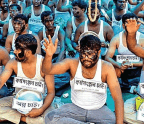
Agiant 10-storey-tall bronze statue of Kempe Gowda, the illustrious founder of Bengaluru, is being installed at the entrance of the city’s swank airport. Back in AD 1537, Gowda, a feudatory of the mighty Vijayanagara empire, built a fort on a 2.4 square kilometre site atop an undulating plateau with a vision of creating a city of the future. Engaging two pairs of bullocks with ploughs, he got one set to walk in the north-south direction and the other in an east-west one. He then built roads along the furrows they created, dividing the city into four zones. Areas for housing, markets, government, and worship were clearly demarcated. The city won praise for its orderly planning from even his emperor, Achyutha Deva Raya. It came to be called Bengaluru, whose meaning ranges from the City of Boiled Beans to the City of White Quartz to the place of the bodyguards, depending on which theory you are partial to.
Cut to the year 2022 and the statue of Gowda stands blindfolded awaiting a formal unveiling, possibly in early November, by Prime Minister Narendra Modi. When the scaffolding is removed, Bengaluru’s founder may not like what he sees of the city he had planned so meticulously. For one, it stretches way, way beyond the fort Gowda built around it, a giant, sprawling megalopolis that continues to expand at an unwieldy pace. In the past decade alone, the city has grown four times in size and now covers a swathe 800 square kilometres in area, joining the league of the world’s fastest growing cities. Its population has almost tripled in the past two decades, from 5.1 million in 2001 to 14.3 million in 2021, making it the third largest metro in the country. It has overtaken Chennai, Kolkata and Hyderabad and has only Delhi and Mumbai as its superiors.
On the surface, though, Bengaluru appears to be a thriving, throbbing conurbation where start-ups spring up like daisies every morning and grow into unicorns (having turnovers of $ 1 billion or more) by sundown. Or even decacorns, like Byju’s, within just a decade of being set up. Bengaluru is now in the race to be the infotech capital of the world, with its tech corridor, a glittering 17-km arc of glass and stainless-steel skyscrapers, housing an estimated 400 of the Fortune 500 corporates. This dense concentration of the world’s top IT and banking firms generates $ 22 billion (Rs 1.8 lakh crore) per annum, accounting for a third of Bengaluru’s revenue and employing close to 1 million people. With migrants forming two-thirds of its population, more than just a melting pot of cultures, the ‘Multiple City’ has a myriad tongues, multiple origins, multi cuisines and cacophony of soundtracks and festivals, as an expert put it.






